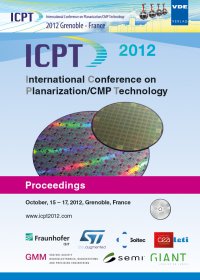Chemical-Mechanical Planarization of Aluminium Damascene Structures
Conference: ICPT 2012 - International Conference on Planarization / CMP Technology
10/15/2012 - 10/17/2012 at Grenoble, France
Proceedings: ICPT 2012
Pages: 6Language: englishTyp: PDF
Personal VDE Members are entitled to a 10% discount on this title
Authors:
Künzelmann, U.; Bartha, J. W. (Institute of Semiconductor and Microsystems Technology, TU Dresden, 01062 Dresden, Germany)
Mueller, M. R.; Kallis, K. T.; Schuette, F. (Intelligent Microsystems Chair, TU Dortmund, Emil-Figge-Str. 68, 44227 Dortmund, Germany)
Menzel, S. (Leibniz Institute for Solid State and Materials Research Dresden, P.O. Box 270116, 01171 Dresden, Germany)
Engels, S. (II. Institute of Physics B, RWTH Aachen University, 52074 Aachen, Germany )
Fong, J.; Lin, C.; Dysard, J. (Cabot Microelectronics Corp., 870 North Commons Drive, Aurora, IL 60504, United States of America)
Knoch, J. (Institute of Semiconductor Electronics, RWTH Aachen University, Sommerfeldstr. 24, 52074 Aachen, Germany)
Abstract:
An aluminium damascene process is applied for the fabrication of buried tri-gate structures which are used as substrates for the investigation of novel channel materials for emerging field-effect transistors. The Al-CMP process with a commercial high performance slurry and post-cleaning system was optimized targeting at minimized dishing and erosion as well as realizing non-contaminated, smooth surfaces without the use of any stop layers. Large crystallites at the surface of the Al structures, so-called hillocks, appear immediately after the CMP-process, but remain stable in size over a long time. First experiments with InAs-nanowires demonstrate the applicability of the tri-gate structures with buried Al. Keywords: Aluminium CMP, Aluminium Damascene Structures, Buried Tri- Gate Structures, Novel Channel Materials, InAs-Nanowires, Hillock Growth


